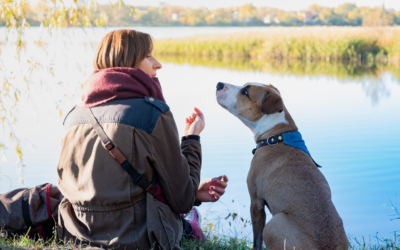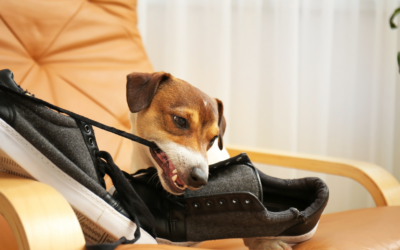Beautiful summer weather unfortunately, for many dog owners, comes with the risk for thunderstorms.
If you’ve ever had a dog with a fear of thunderstorms, you know how horrible it can be to watch them panic. Tail tucked, shivering, panting and drooling, either hiding or not leaving your side, all over a storm going by.
This fear very often translates to fear of other noises as well. Dogs having noise phobias such as fireworks and vacuum cleaners are more likely in dogs that are fearful of storms.

Thunderstorms can be very difficult for dogs, as they come along with many changes in their environment. There are low, loud noises that have vibration associated with them. There is a change of pressure in the air, static electricity, and changes in ozone levels.
With a young dog that isn’t afraid of storms, you can do many things to help prevent fear of storms when there isn’t a storm around.
How to prevent fear of storms
1. Socialization
Firstly, proper socialization helps. Positive exposures to people, noises, other animals, different scenarios, everything you can think of, especially during their socialization period (approximately 6 to 14 weeks of age) is very important. Socialization helps to prevent general fearfulness in dogs. Finding a puppy class that you can enroll your puppy in early will help you achieve some of your socialization goals.
2. Positive experience with noises
Secondly, you can expose your puppy ahead of time to one of the aspects of a storm, the noises. There are many apps, YouTube sites, and websites that have storm noises available. When your dog is young, having these playing at very low levels while they’re having meals or receiving treats will help them get used to those noises. You want to do this at very low levels, especially when first exposing your dog, so that they are not fearful. If they’re unwilling to eat, then the volume is too high and you should try again at a much lower volume the next meal.
What about when a storm is coming?
1. Be prepared – have treats or food available. Slowly give treats, a food-filled kong, or another favourite when it is storming. If they begin to take food roughly or are panting and showing other signs of stress, increase the speed you’re giving treats and/or the value of the treat. (If you need information about the value to different types of treats and rewards, you can learn all about it here).
2. If at all possible, try to be with your dog so they don’t experience their first storms alone.
3. Do not put on loud music or something to cover the sound of the storm. If your dog isn’t fearful, you actually want them to hear the sound and to associate that with something positive to help prevent fear in the future.



